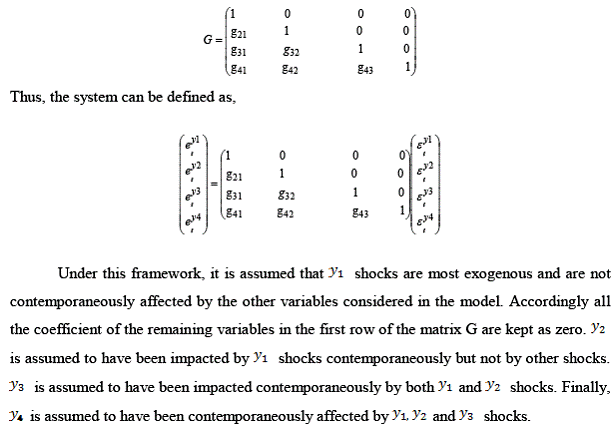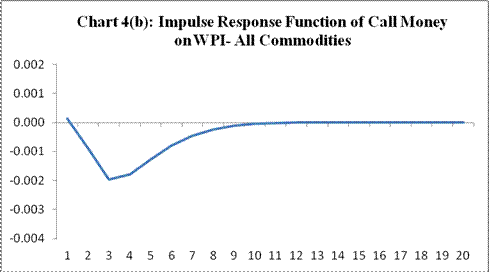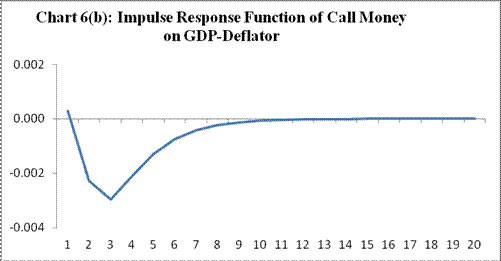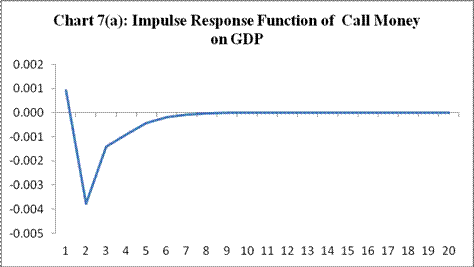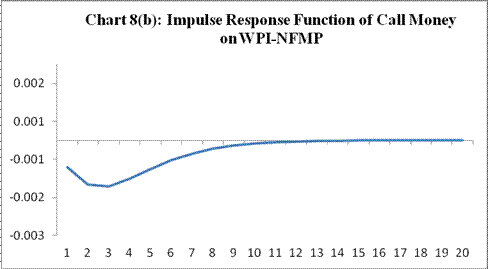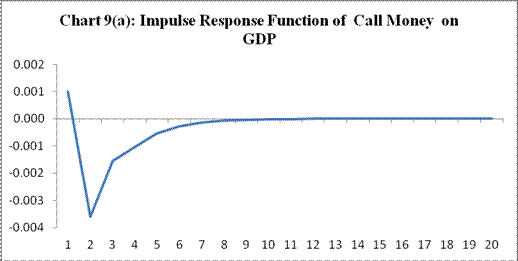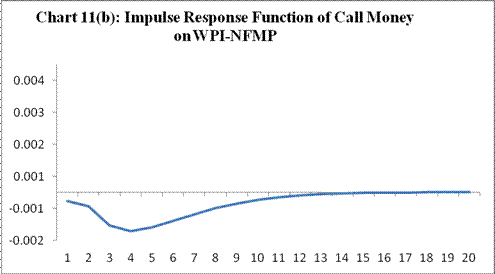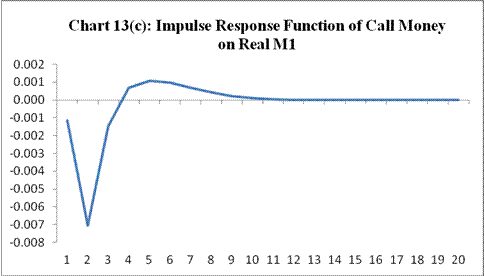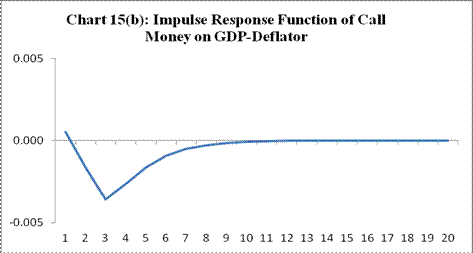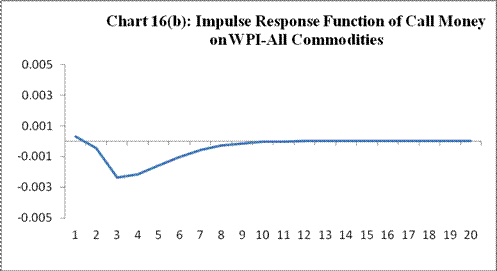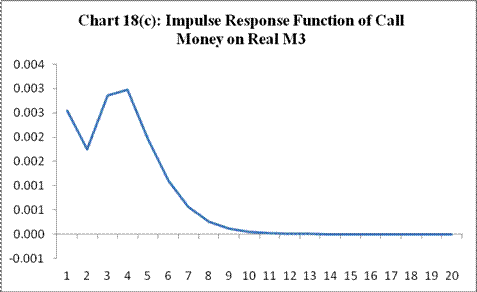RBI WPS (DEPR) : 6/2012: Evidence of Interest Rate Channel of Monetary Policy Transmission in India
| RBI Working Paper Series No. 06 * With the development of domestic financial markets and gradual deregulation of interest rates, monetary policy operating procedure in India in the recent years has evolved towards greater reliance on interest rates to signal the stance of monetary policy. This process is buttressed by significant evidence that policy rate changes transmit through the term structure of interest rates, though the intensity of transmission varies across financial markets. But how does policy rate change affect output and inflation remains an open question. Following a quarterly structural vector auto-regression (SVAR) model, we find evidence that policy rate increases have a negative effect on output growth with a lag of two quarters and a moderating impact on inflation with a lag of three quarters. The overall impact persists through 8-10 quarters. These results are found to be robust across alternative specifications with different measures of output, inflation and liquidity. Moreover, significant unidirectional causality was found from policy interest rate to output, inflation and various measures of liquidity except broad money (M3), underlining the importance of interest rate as a potent monetary policy tool. JEL Classification: E43, E52, E58 Key words: Interest Rate Channel, Monetary Policy, Monetary Transmission, Structural VAR 1. Introduction How does monetary policy affect output and inflation is an important question. The monetary policy framework of a central bank aims to attain the desired objectives of policy in terms of inflation and growth. Typically, central banks exercise control over the monetary base and/or short term interest rates such as the rate at which the central bank supplies or absorbs reserves to/from the banking system in the economy. How these interest rate actions and liquidity operations of the central banks impact the end-objectives depends on the underlying monetary transmission. Monetary transmission refers to a process through which changes in the policy get translated into the ultimate objectives of inflation and growth. Traditionally, four key channels of monetary policy transmission have been identified in literature such as (i) quantum channel relating to money supply and credit; (ii) interest rate channel; (iii) exchange rate channel; and (iv) asset price channel. In recent years, a fifth channel, i.e., expectations channel has assumed increased prominence in the conduct of forward-looking monetary policy. Literature also makes a distinction of monetary transmission through two sets of channels: (i) neoclassical channels and (ii) non-neoclassical channels. The neoclassical channels focus on how interest rate changes operating through investment, consumption and trade impact the ultimate objectives. The non-neoclassical channels operate primarily through change in credit supply and impact on the behavior of banks and their balance sheets [Boivin et al., 2011]. How these channels function in a given economy depends on the stage of development of the economy and the structure of its financial system. Interestingly, the channels of monetary transmission are often referred to as a black box – implying that we know that monetary policy does influence output and inflation but we do not know for certain how precisely it does so. This is because not only different channels of monetary transmission tend to operate at the same time but also they change over time. As Bernanke and Gertler [1995] observed: to a large extent, empirical analysis of the effects of monetary policy has treated monetary transmission mechanism itself as a “black box”. As a result, questions remain: does monetary policy affect the real economy? If so, what is the transmission mechanism by which these effects take place? Monetary policy changes affect market interest rates such as bank lending and bank deposit rates in varying degrees over time. Changes in interest rates by the monetary authorities could also induce movements in asset prices to generate wealth effects in terms of market valuations of financial assets and liabilities. Higher interest rates can induce an appreciation of the domestic currency, which in turn, can influence net exports and, hence, aggregate demand and output. At the same time, policy actions and announcements affect expectations about the future course of the economy and the degree of confidence with which these expectations are held. On the output side, these changes affect the spending, saving and investment behaviour of individuals and firms in the economy. In a simplistic view, other things being equal, higher interest rates tend to encourage saving rather than spending. Similarly, a higher value of currency in the foreign exchange market encourages spending by making foreign goods less expensive relative to goods produced at home. So changes in the interest rate and exchange rate affect the demand for goods and services produced. On the inflation front, the level of demand relative to domestic supply capacity - in the labour market and elsewhere - is a key influence on domestic inflationary pressure. If demand for labour exceeds the supply, there will be upward pressure on wages, which some firms will be able to pass into higher prices charged to consumers. Also, exchange rate movements have a direct effect on the domestic prices of imported goods and services, and an indirect effect on the prices of those goods and services that compete with imports or use imported inputs, and thus on the component of overall inflation. In general, transmission mechanism is largely conditioned by the monetary policy framework, structure and depth of the financial system in which the central bank operates and the state of real economy. While there is vast empirical literature on monetary policy transmission for advanced economies, only a limited number of empirical studies have examined the monetary transmission mechanisms in emerging and developing economies (EDEs). This is understandable given the underdeveloped nature of financial markets and rapid structural changes in EDEs. However, since the 2000s, analysis of monetary transmission mechanisms in EDEs, including India, has gained prominence due to structural and economic reforms and subsequent transitions to market oriented policy regimes. Literature on monetary transmission in India is still in a nascent stage, though in the recent times, quite a few studies using traditional vector auto-regression (VAR) and structural vector auto-regression (SVAR) approaches have been attempted. However, from a practitioner’s stand point, the impact of the policy interest rate changes of Reserve Bank of India (RBI) on the real economy and inflation still remains an open question. Against this background, this paper presents an empirical evidence of interest rate channels of monetary policy transmission in India based on a quarterly SVAR framework. The paper is organised as follows. In Section 2, we review the literature, covering both theory and empirical evidence, in the international context as well as in India. In section 3, we briefly capture the evolution of monetary policy operating framework in India. In section 4, we discuss the development of financial markets and inter-linkages in interest rates across markets. In Section 5, the dynamic responses of output and inflation to monetary policy innovations are estimated using a quarterly SVAR model. Section 6 presents the conclusions. 2. Literature Review: Theory and Evidence In the literature, there is a general recognition that monetary policy affects real economy at least in the short run. However, there is no general agreement on the channel through which monetary policy influences the behaviour of output and prices. The theoretical explanations on monetary policy transmission have evolved over the years, with major episodes of crises playing an important role in prompting revaluations of earlier tenets. Keynes in his general theory of output and employment described the importance of interest rate channel of monetary policy transmission. Monetarist characterisation of transmission mechanism by Friedman and Schwartz [1963] emphasised the role of money supply besides other assets. Life cycle hypothesis by Ando and Modigliani [1963] emphasised the wealth effect, while Tobin [1969] highlighted the importance of the cost of capital and portfolio choice in the transmission of monetary policy. In the recent years, monetary policy transmission has been an issue of extensive research particularly since Bernanke’s seminal article in 1986 which provided alternative explanations of real and nominal sources of prices for explaining money-income relationship. However, the findings on the efficacy of various channels of transmission remain an unresolved issue. Bernanke and Blinder [1988] pointed out the importance of credit channel of monetary policy transmission in the US. However, Romer and Romer [1990] did not find support for credit channel of monetary transmission. This lack of a consensus on the channels of monetary transmission can be clearly seen from the debate in a Symposium on ‘The Monetary Policy Transmission’ published in the Journal of Economic Perspectives in 1995. Taylor [1995] using a financial market prices framework reviewed the impact of monetary policy transmission on real GDP and prices, and found the traditional interest rate channel to be an important channel. Obstfeld and Rogoff [1995] emphasised the importance of exchange rate channel and concluded that the conduct of monetary policy has international implications. Meltzer [1995] re-emphasised transmission through multiple asset prices, extending beyond interest rates, exchange rate and equity prices. Bernanke and Gertler [1995] contested the efficacy of interest rate channel. They argued that monetary policy affects short-term interest rates but has little impact on long-term interest rates which can only have large effects on purchases of durable assets, implying monetary policy ineffectiveness. They argued that the puzzle could be resolved through the credit channel of transmission. Edwards and Mishkin [1995], however, doubted the effectiveness of the bank lending channel arguing that with financial innovations, banks were becoming increasingly less important in credit markets. Given these contrasting views, Mishkin [1995, 1996 and 2001] provided an overview on the working of various channels for better understanding of monetary policy transmission. Notwithstanding the various theoretical perspectives and the lack of a consensus, several empirical studies have tried to identify the various channels of monetary policy transmission across a number of countries. Using VECM approach, Ramey [1993] found that the money channel was much more important than credit channel in explaining the direct transmission of monetary policy shock on the US economy. Recognising the importance of financial frictions despite developments in macroeconomics, Bean et al. [2002] highlighted the inadequacy of interest rate channel in explaining the impact of monetary policy shock on demand. In the euro area countries, Smets and Wouters [2002] found that monetary policy shock via the interest rate channel affected real output, consumption and investment demand. Angeloni et al. [2003] also found the interest rate channel to be the completely dominant channel of transmission in a few euro area countries, while being an important channel in almost all of them. Where the interest rate channel was not dominant, either bank lending channel or other financial transmission channel was present. Surveying the empirical studies on monetary policy transmission then, Loyaza and Schmidt-Hebbel [2002] concluded that traditional interest rate channel was still the most relevant channel in influencing output and prices, while exchange rate channel became important in open economies. Recent survey by Boivin et al. [2010] also concluded that the neoclassical channels, i.e., direct interest rate effects on investment spending, wealth and inter-temporal substitution effects on consumption, and the trade effects through the exchange rate, continued to remain the core channels in macroeconomic modelling, while there was little evidence on the efficacy of bank-based non-neoclassical channels of transmission. Empirical results also show that the experience of monetary policy of the US Federal Reserve (Fed) vis-à-vis the European Central Bank (ECB) during 2001-2007 was different. During this period, the Fed cut interest rates more vigorously than the ECB. By comparison with the Fed, the ECB followed a more measured course of action. Using a DSGE model with financial frictions, Christiano, et al. [2008] found that the ECB's policy actions had a greater stabilising effect than those of the Fed. As a consequence, a potentially severe recession turned out to be only a slowdown, and inflation never departed from levels consistent with the ECB's quantitative definition of price stability. Other factors that account for the different economic outcomes in the euro area and the US include differences in shocks and differences in the degree of wage and price flexibility. A number of studies have also examined the efficacy of various channels in EDEs with contrasting results. Using VAR framework, Disyatat and Vongsinsirikul [2003], in Thailand, found that in addition to the traditional interest rate channel, banks play an important role in monetary policy transmission mechanism, while exchange rate and asset price channels were relatively less significant. In Sri Lanka, Amarasekara [2008] found interest rate channel to be important for monetary policy transmission. For the Philippines, Bayangos [2010] found the credit channel of monetary transmission to be important. In the case of South Africa, Kabundi and Nonhlanhla [2011] using a FAVAR framework concluded that monetary policy shock had a short-lived impact on both the real economy and prices, and in addition to interest rate channel, found confidence channel to be important in monetary policy transmission. Ncube and Ndou [2011] showed that monetary policy tightening in South Africa can marginally weaken inflationary pressures through household wealth and the credit channel. Mohanty and Turner [2008] argued that credible monetary policy frameworks put in place across EMEs in recent years have strengthened the interest rate channel of monetary policy transmission. Mukherjee and Bhattacharya [2011] found that the interest rate channel impacts private consumption and investment in EMEs, with and without inflation targeting. Acosta-Ormaechea and Coble [2011] comparing the monetary policy transmission in dollarised and non-dollarised economies found that the traditional interest rate channel was found to be more important in Chile and New Zealand while the exchange rate channel played a more substantial role in controlling inflationary pressures in Peru and Uruguay. Some studies, on the other hand, have argued that monetary policy transmission is weak in the EMEs and low income countries. Reviewing monetary policy transmission in low income countries, Mishra et al. [2010] found that weak institutional mechanism impaired the efficacy of traditional monetary transmission channels viz., interest rate, bank lending, and asset price. Similarly, for a group of EMEs, Bhattacharya et al. [2011] argued that the weakness in domestic financial system and the presence of a large and segmented informal sector led to ineffective monetary policy transmission. Based on VECM model, they suggested that the most effective mechanism of monetary policy impacting inflation was through the exchange rate channel, while interest rates did not affect aggregate demand. The recent financial crisis has shown the inadequacy in monetary transmission mechanism through the traditional channels. Thus, during the post-crisis period, a number of studies have attempted to capture the additional dimensions of central bank policy that have been at the center stage for policy transmission. While research prior to the crisis often cast doubts on the strength of the bank lending channel, evidence during crisis showed that bank-specific characteristics, financial innovations, business models can have implications for provision of credit and smooth transmission of monetary policy. Therefore, the recent crisis has clearly highlighted the role of banks as a potential source of frictions in the transmission mechanism of monetary policy. Cecchetti et al. [2009] emphasised that the disentangling effects of the various channels during the crisis period was difficult. They pointed out that the crisis, in fact, has exposed the inadequacy of models which could not examine (i) the role that financial factors play in the monetary policy transmission process through various channels and (ii) how financial disturbances can be amplified and spill over to the real economy. Walsh [2009] argued that financial frictions, albeit not a part of consensus model of monetary policy, affect both the monetary policy transmission process and generate distortions in the real economy. For the euro area, ECB [2010] found that during the recent episode of financial turmoil, non-standard monetary policy measures undertaken to keep the interest rate pass-through channel operational proved to be effective. Trichet [2011] emphasised that even though non-standard measures helped restoring the monetary policy transmission during crisis, they needed to be pursued independently from standard measures. Taylor and Williams [2010] viewed that though simple interest rate rules have worked well in transmitting the monetary policy, further research was needed that incorporates a wider set of models and economic environments, especially international linkages of monetary policy. Recognizing the large scale use of unconventional monetary policy measures through quantitative easing during the recent crisis, Curdia and Woodford [2010] extended the basic New Keynesian model of monetary transmission mechanism to explicitly include the central bank's balance sheet. Highlighting the role of financial intermediaries in monetary policy transmission, Bean et al. [2010] have emphasised that the role of monetary policy in the run up to crisis was less through conventional monetary policy channels but more from ‘risk taking channel’. Bernanke [2011] and Yellen [2011] argued that the transmission channels through which unconventional and conventional monetary policy affect economic conditions are quite similar. However, Yellen [2011] highlighted the importance of ‘portfolio balance channel’ and ‘expectations’ channel during crisis. Analysing the impact of quantitative easing adopted during recent global financial crisis on the UK economy, Joyce et al. [2011] have highlighted the importance of the different transmission channels, particularly asset prices which were expected to have conventional effects on output and inflation. In short, crisis has highlighted two important aspects of monetary policy transmission. First, due to information asymmetries and other inefficiencies across financial markets, the conventional channels of monetary policy transmission may not always work effectively. In this context, a number of studies have underscored the importance of financial intermediaries’ stability to facilitate a smooth transmission of policy. Second, when the traditional interest rate channel of the monetary policy transmission mechanism broke down after policy rates reached the zero lower bound during crisis, the role of unconventional policy measures became more prominent which worked mainly through asset price and expectations channels. A number of studies have also examined the importance of different channels of monetary policy transmission in India. Al-Mashat [2003] using a structural VECM model for the period 1980:Q1 to 2002:Q4 found interest rate and exchange rate channels to be important in the transmission of monetary policy shocks on key macroeconomic variables. Bank lending was not an important channel due to the presence of directed lending under priority sector. On the other hand, Aleem [2010] studying credit channel, asset price channel and exchange rate channel of monetary policy transmission using VAR models for the period 1996:Q4 to 2007:Q4 found credit channel to be the only important channel of monetary transmission in India. The RBI Working Group on Money Supply (Chairman: Y.V. Reddy, 1998) pointed to some evidence of interest rate channel of monetary transmission. RBI [2005] using a VAR framework for the period 1994-95 to 2003-04 found that monetary tightening through a positive shock to the Bank Rate had the expected negative effect on output and prices with the peak effect occurring after around six months. Monetary easing through a positive shock to broad money had a positive effect on output and prices with peak effect occurring after about two years and one year, respectively. Further, exchange rate depreciation led to increase in prices with the peak effect after six months and a positive impact on output. Using cointegrated VAR approach, Singh and Kalirajan [2007] showed the significance of interest rate as the major policy variable for conducting monetary policy in the post-liberalised Indian economy, with CRR playing a complementary role. Patra and Kapur [2010] also found that aggregate demand responds to interest rate changes with a lag of at least three quarters. However, they pointed out that the presence of institutional impediments in the credit market such as administered interest rates could lead to persistence of the impact of monetary policy up to two years. Bhaumik et al. [2010] highlighted the importance of bank ownership in monetary policy transmission through the credit channel. Pandit and Vashisht [2011] found that policy rate channel of transmission mechanism, a hybrid of the traditional interest rate channel and credit channel, works in India, as in other six EMEs considered by them. 3. Evolution of Monetary Policy Operating Framework in India In India, as in most countries, monetary policy framework has evolved in response to and in consequence of financial developments, openness and shifts in the underlying transmission mechanism. The evolution of monetary policy framework in India can be seen in phases. The Reserve Bank of India (RBI) was established in 1935. Since the formative years during 1935–1950, the focus of monetary policy was to regulate the supply of and demand for credit in the economy through the Bank Rate, reserve requirements and open market operations (OMO). During the development phase during 1951–1970, monetary policy was geared towards supporting plan financing, which led to introduction of several quantitative control measures to contain the consequent inflationary pressures. While ensuring credit to preferred sectors, the Bank Rate was often used as a monetary policy instrument. During 1971–90, the focus of monetary policy was on credit planning. Both the statutory liquidity ratio (SLR) and the cash reserve ratio (CRR) prescribed for banks were used to balance government financing and inflationary pressure. The 1980s saw the formal adoption of monetary targeting framework based on the recommendations of Chakravarty Committee (1985). Under this framework, reserve money was used as operating target and broad money (M3) as an intermediate target. Subsequently, structural reforms and financial liberalisation in the 1990s led to a shift in the financing paradigm for the government and commercial sectors with increasingly market-determined interest rates and exchange rate. By the second half of the 1990s, in its liquidity management operations, the RBI was able to move away from direct instruments to indirect market-based instruments. Beginning in April 1999, the RBI introduced a full-fledged liquidity adjustment facility (LAF) and it was operated through overnight fixed rate repo and reverse repo from November 2004. This helped to develop interest rate as an important instrument of monetary transmission. However, this framework witnessed certain limitations due to lack of a single policy rate and the absence of a firm corridor. Against this background, RBI introduced a new operating procedure in May 2011 where the weighted average overnight call money rate was explicitly recognised as the operating target of monetary policy and the repo rate was made the only one independently varying policy rate (RBI, 2011). The new operating framework with the modified LAF underlines the dominance of the interest rate channel of monetary transmission. This means that once the RBI changes policy repo rate, it should immediately impact the overnight interest rate which is the operational rate and then transmit through the term structure of interest rates as well as bank lending rates. Dominance of this channel was also evident from the policy actions of RBI. Over the years, in comparison with other monetary policy instruments, the use of interest rate instruments (Repo and Reverse Repo) by RBI has been more frequent (Table 1). Except for the year 2008-09, when CRR and repo rate were reduced 10 times and 8 times, respectively, in the wake of global financial crisis, RBI has shown increased preference of using interest rate as a primary tool of monetary policy. A snapshot of RBI’s policy stance and its policy changes since 2001 is given in the Annex 1. 4. Development of Financial Markets and Interest Rate Inter-linkages across Markets An effective implementation of monetary policy needs an assessment of how the monetary policy changes propagate through the financial markets and the broader economy. In general, monetary policy gets transmitted to final objectives of inflation and growth through two stages. In the first stage, policy changes transmit through the financial system by altering financial prices and quantities. In the second stage, financial prices and quantities influence the real economy by altering aggregate spending decisions of households and firms, and hence the aggregate demand and inflation. Nonetheless, whether monetary policy actions influence the spectrum of market interest rates would inter alia depend upon the level of development of various segments of financial markets. Cross-country studies suggest that as domestic financial markets grow, transmission of monetary policy through financial channels becomes better. Therefore, before going for empirical investigation onto the impact of monetary policy on various segments of financial markets, it is important to briefly review the policy measures which have been taken during the post-reform period to deepen interest rate inter-linkages. Various measures were taken to facilitate the process of price discovery in different segments of financial markets which inter alia included deregulation of interest rates; auction-based market borrowing programme of the government; development of short-term money markets through introduction of money market instruments; discontinuation of automatic monetisation by phasing out of ad hoc Treasury Bills; replacing cash credit with term loans; and reduction in statutory reserve requirements. These reforms facilitated a shift in the operating framework for monetary management from direct instruments to interest rate based indirect instruments. Even though the financial reforms began in the early 1990s, the impact was evident from the late 1990s. Money Market: The development in money market assumes prime importance as it is a key link in the transmission mechanism of monetary policy to financial markets and finally, to the real economy. The call money market was developed into primarily an inter-bank market, while encouraging other market participants to migrate towards collateralised segments of the market, thereby increasing overall market integrity. In order to facilitate the phasing out of corporates and the non-banks from the call money market, new instruments, e.g., market repos and collateralized borrowing and lending obligations (CBLO) were created to provide them avenues for managing their short-term liquidity. Non-bank entities completely exited the call money market in August 2005. Maturities of other existing instruments such as CP and CDs were also gradually shortened. Debt Market: Another segment of financial markets which plays a crucial role in the monetary policy transmission mechanism is the debt market, in particular, the government securities market as it is the predominant segment of the overall debt market in India. Banks still statutorily hold 24 per cent of their net demand and time liabilities (NDTL) in government securities. One of the key policy developments that enabled a more independent monetary policy environment as well as the development of government securities market was the discontinuation of automatic monetisation of the government's fiscal deficit since April 1997. This reinforced the auction based system in the government securities market which was introduced in 1992. The Primary Dealer (PD) system was also revamped to ensure a more dynamic and active participation of PDs in view of the provisions of the Fiscal Responsibility and Budget Management (FRBM) Act 2003 whereby the Reserve Bank was prohibited from participating in the primary market effective April 2006. As a result, a shift towards market-based financing of the government borrowings and an active secondary market for government securities expanded the eligible set of collaterals which enabled the RBI to more effectively conduct monetary policy through indirect instruments. While the government securities market in India is considered to be well developed now, the corporate debt market remains comparatively less developed with implications for monetary transmission. Credit Market: Prior to the 1990s, credit market in India was tightly regulated through credit controls, directed lending and administered interest rates. However, with financial reforms pursued since the early 1990s, not only the banks were provided flexibility to price their products based on their risk assessment but also restrictions on lending for project finance activity and for personal loans were gradually withdrawn. Furthermore, international best practices were progressively adopted in respect of regulatory norms on capital adequacy, income recognition, asset classification and provisioning. The problem arising out of segmentation of the credit market was addressed with banks providing long-term loans, apart from the traditional short-term funds for working capital. The linkage between the credit market and the equity market has also grown on account of participation by banks in the equity market for raising capital. Foreign Exchange Market: There was a phased transition from a pegged exchange rate regime to an increasingly market determined exchange rate regime in 1993 and the subsequent adoption of current account convertibility in 1994 and significant liberalisation of capital account transactions. The increasing freedom given to corporates and banks to borrow abroad and use derivative products enhanced the linkage of Indian foreign exchange market with the global financial system. Asset Market: Stock prices are among the most closely watched asset prices in the economy. Equity market in India has witnessed a series of reforms which were aimed at boosting competitive conditions through improved price discovery mechanism; putting in place an appropriate regulatory framework; reducing the transaction costs; and reducing information asymmetry, thereby boosting the investor confidence. Integration across financial markets As price discovery improves and the range of instruments expands, economic agents tend to hold more interest rate sensitive instruments in their balance sheets. Similarly, increasing monetisation and progress towards financial inclusion have also expanded the formal financial system in the economy which ought to enhance the scope of monetary transmission. Given the various policy measures initiated during post-reform period to develop different segments of financial market, it is expected that interest rate structure shares an equilibrium relationship across markets. To test this proposition, we first examined Granger’s causality across markets based on a VAR framework using monthly data from April 2001 to March 2011. Two blocks were considered, viz., (i) policy variable – proxied by monthly average Call Money Rate (CMR) and (ii) other financial market variables. The latter include yield on government securities with residual maturity of 10-years (GoI_10Y) and yield on the 5-year ‘AAA’ rated corporate bonds (AAA_5Y) representing debt market, weighted average lending rate (WALR) indicating credit market1, BSE sensex (Sensex) showing equity market, and Rupee per US dollar (RSUSD) representing foreign exchange market. The test was repeated by replacing AAA_5Y by the yield of the 10-year ‘AAA’ rated corporate bonds (AAA_10Y) and results are presented in Table 2. Results of the block exogeneity test show that there exists bi-directional causality between call money market and other segments of the financial market. In order to examine the equilibrium relationship across markets, a cointegration test is conducted using the same data among the four variables. The ADF and Zivot-Andrews test were applied to test for the order of integration. All variables were found to be non-stationary in level form and stationary in differenced form2 (Table 3). Johansen’s cointegration test suggests the existence of two long-run relationships between the variables at 1 per cent level of significance (Table 4). This suggests that innovations in monetary policy get transmitted to the array of interest rates and other key asset market rates. 5. Response of Output and Inflation to Monetary Policy Innovations: A SVAR Model Sim’s vector auto-regression (VAR) methodology has been extensively used in examining the efficacy of monetary policy transmission across several countries. This approach provides a major advantage of taking into account the simultaneity between monetary policy instruments and relevant macroeconomic variables. However, there are several versions of VAR models to examine monetary policy transmission such as the traditional VAR, Structural VAR (SVAR) and Factor Augmented VAR (FAVAR). SVAR models, unlike in the traditional VAR models, provide explicit behavioral interpretations for all the parameters. Following Bernanke and Blinder (1992), we use a standard SVAR approach to examine how monetary policy shocks affect the real economy. SVAR is a multivariate, linear representation of a vector of observables on its own lags and (possibly) other variables as a trend or a constant. The interpretations of SVAR models require additional identifying assumptions that must be motivated based on institutional knowledge, economic theory, or other extraneous constraints on the model responses. Only after decomposing forecast errors into structural shocks that are mutually uncorrelated and have an economic interpretation, one assesses the causal effects of these shocks on the model variables.
Empirical Results As we examined in the earlier section and corroborated in a number of earlier studies, there is strong evidence of transmission of policy rate changes through the term structure of interest rates, though the strength of transmission varies across markets.3 However, the impact of changes in policy rate on output and inflation and periodicity of lags are open questions. Our empirical exercise seeks to address these questions in a parsimonious SVAR model of four variables y1,y2,y3 and y4as output, inflation, policy interest rate and money (or credit). This structure explicitly assumes that the real output shocks are mostly exogenous and are not contemporaneously affected by the other variables considered in the model. Price is assumed to have been impacted by the real output shocks contemporaneously but not by other shocks. The policy rate is assumed to have been impacted contemporaneously by both output and price shocks. Finally, the money supply (or credit) is assumed to have been contemporaneously affected by the real output shocks, price shocks and monetary policy shocks. In order to test the robustness of the model and to examine the variability of impact of monetary policy action on other variables, alternative measures of the variables were taken. Monetary policy rate is proxied by weighted average overnight call money rate as this is the operating target of the RBI.4 As a variant to GDP, non-agricultural GDP (NAGDP) was also selected. As price index, three different price indicators, viz., the headline wholesale price index (WPI), non-food manufactured products index (NFMPI) and GDP-deflator were chosen.5 As quantity variable, three different variables, viz., non-food credit, narrow money (M1) and broad money (M3) were included in the model, alternatively with one at a time. In general, quantity variables such as M1, M3, credit and liquidity were used in real terms. Alternative specifications were also estimated using these quantity variables in nominal terms. In general, estimation of any VAR model requires long time series data. In the Indian context, quarterly GDP data are available only from 1996-97:Q1. Accordingly, the models were estimated using quarterly data from 1996-97:Q1 to 2010-11:Q4.6 Except policy interest rate variable, all other variables are seasonally adjusted using X-12 ARIMA and enter into the model in log-first differenced form. Depending on the choice of reference variables, 24 models were estimated. In this paper, since we primarily seek to determine the impact of policy rate changes on output and inflation variability, impulse response functions (IRF) for each model were analysed. These are reported in Annex 2. From the impulse response functions, the following key inferences can be drawn. (i) Monetary Policy Effect on Output The impulse response functions imply that increase in policy interest rate is associated with a fall in real GDP growth rate. The maximum decline in GDP growth occurs with a lag of two quarter with the overall impact continuing through 6-8 quarters ahead. The impulse response is broadly similar with the alternative models with variants of output, inflation, money and credit. (ii) Monetary Policy Impact on Inflation The impulse response functions imply that increase in policy interest rate has a negative impact on inflation rate across the alternative measures of inflation. The maximum decline in inflation was observed with a lag of three quarters with the overall impact continuing through 8-10 quarters. Causality Analysis In order to assess causality between financial variables including the policy rate and macroeconomic variables of growth and inflation, block exogeneity tests were conducted. First, the model was divided into two blocks. One block included the macro-variables (output and inflation), while the other block covered the financial variables such as the policy interest rate, monetary aggregates and credit. Generally, bidirectional causality was found between the two sets of blocks (Annex 3). This suggests that while monetary policy responds to changes in output and inflation, they in turn influence monetary variables. Second, with a view to examining how changes in policy rate affect other set of variables, alternative block exogeneity test was performed with the first block as policy rate (call money rate) and the second block consisting of other variables, i.e., output, inflation and a quantity variable such as money or credit. In this case, empirical results suggest a unidirectional causality running from changes in policy rate to other set of variables (Annex 4). The results were similar when money and credit were used in real terms except for broad money (M3). The results indicate that changes in policy rates does impact overall economic activity. However, results of the Granger’s causality tests should be interpreted with the caution that past monetary policy actions, along with past economic activities, predict future economic activities better than past economic activities alone. During last two decades, substantial research efforts have been devoted to understanding the monetary transmission mechanism, especially in developed nations. Assessment of performance of monetary policy has been challenging because of the unresolved questions concerning channels of transmissions. In the absence of any unique mechanism, several theories have been postulated and multiple channels are observed in the literature. However, such exploration has been limited in emerging economies. In this context, this paper provides empirical evidence of interest rate channel of monetary policy in India. With the development of domestic financial markets and gradual deregulation of interest rates, monetary policy operating procedure in India in the recent years has evolved towards greater reliance on interest rates to signal the stance of monetary policy. This process is buttressed by significant evidence that policy rate changes transmit through the term structure of interest rates, though the intensity of transmission varies across financial markets. Following a quarterly structural vector auto-regression (SVAR) model, we find evidence that policy rate increases have a negative effect on output growth with a lag of two quarters and a moderating impact on inflation with a lag of three quarters. The overall impact persists through 8-10 quarters. These results are found to be robust across alternative specifications with different measures of output, inflation and liquidity. Moreover, significant unidirectional causality was found from policy interest rate to output, inflation and various measures of liquidity except broad money (M3), underlining the importance of interest rate as a potent monetary policy tool. @An earlier version of this paper was presented in the Second International Research Conference of RBI held during February 1-2, 2012 at Mumbai. * The author would like to acknowledge the invaluable technical support provided by A.B. Chakraborty, Jeevan Khundrakpam, Abhiman Das, Rajeev Jain, Sanjib Bordoloi and Dipankar Biswas. The views expressed in the paper are that of the author and not necessarily that of Reserve Bank of India. 1 First annual weighted average lending rates for scheduled commercial banks were computed by using Basic Statistical Returns (BSR) data, then converted to monthly frequency on the basis of trend in call money data. 2 The ADF test indicates Call Money Rate to be stationary at level, while Zivot-Andrews test indicates it to be first difference stationary. 3 The RBI Working Group on Operating Procedure of Monetary Policy (Chairman: Deepak Mohanty, 2011) found that the impact of interest rate channel of monetary transmission varies across the segments of the financial markets, but it is the strongest in the money market. A 100 basis points change in the policy repo rate causes a change of around 80 basis points in the weighted average call money rate. 4 Since May 2011, the repo rate (RBI liquidity injection rate), has emerged as the policy rate to signal the stance of monetary policy. Prior to this, the repo rate served as the policy rates in the times of systemic liquidity deficit and the reverse repo rate (RBI liquidity absorption rate) served as the policy rate at times of systemic liquidity surplus. However, the overnight call money rate reflected the liquidity conditions through the regimes with a strong correlation with the policy rates. 5 Non-food manufactured products inflation having a weight of 55 per cent in WPI is treated as core inflation by the RBI. 6 While formally transition to a full-fledged LAF was made in three stages beginning June 2000, call money rate was a key monetary indicator in the immediate preceding period which motivated the model estimation from 1996-97:Q1 to capture maximum number of observations. References: Acosta-Ormaechea, Santiago and David Coble [2011]. “Monetary transmission in dollarized and non-dollarized economies: The cases of Chile, New Zealand, Peru and Uruguay”, IMF Working Paper No.11/87, International Monetary Fund. Aleem, Abdul [2010]. “Transmission mechanism of monetary policy in India”, Journal of Asian Economics, 21, 186-197. Al-Mashat, R. [2003]. Monetary policy transmission in India: Selected issues and statistical appendix. Country report no. 03/261, International Monetary Fund. Amarasekar, C. [2008]. “The impact of monetary policy on economic growth and inflation in Sri Lanka”. CBSL Staff Studies, 38, No 1&2. Ando, Albert, and Franco Modigliani [1963]. “The ‘life-cycle’ hypothesis of saving: aggregate implications and tests,” American Economic Review, 53, 55–84. Angeloni, Ignazio; Anil K Kashyap; Benoît Mojon and Daniele Terlizzese [2003]. “Monetary transmission in the euro area: does the interest rate channel explain all?”, NBER Working Paper No. 9984, National Bureau of Economic Research. Bayangos, Veronica B. [2010]. “Does the bank credit channel of monetary policy matter in the Philippines?”, available at www.bis.org/repofficepubl/arpresearch201003.12.pdf Bean, Charles; Jens Larsen and Kalin Nikolov [2002]. “Financial frictions and the monetary transmission mechanism: theory, evidence and policy implications”, ECB Working Paper No.113, European Central Bank. Bean, Charles; Matthias Paustian, Adrian Penalver and Tim Taylor [2010]. “Monetary policy after fall”, paper presented at Jackson Hole Symposium Wyoming, September 16. Bernanke, Ben S. [1986]. “Alternative explanations of the money-income correlation,” Carnegie-Rochester Conference Series on Public Policy, Elsevier, Vol. 25, 49-99. Bernanke, Ben S. and Alan S. Blinder [1988]. “Credit, money, and aggregate demand”, American Economic Review Papers and Proceedings, 78, 435-439. Bernanke, Ben and Alan Blinder [1992]. “The federal funds rate and the channels of monetary transmission”, American Economic Review, 82, 901-21. Bernanke, Ben and Mark Gertler [1995]. “Inside the black box: the credit channel of monetary transmission”, Journal of Economic Perspectives, 9, 27-48. Bernanke, Ben S. [2011]. “The economic outlook and macroeconomic policy”, Speech at the National Press Club, Washington, D.C., February 3. Bhaumik, S. K., Vinh Dang and Ali M. Kutan. [2011]. “Implications of bank ownership for the credit channel of monetary policy transmission: evidence from India”, Journal of Banking and Finance, 35, 2418-28. Bhattacharya, Rudrani; Ila Patnaik and Ajay Shah [2011]. “Monetary policy transmission in an emerging market setting”, IMF Working Paper No.11/5. Boivin, Jean, Michael T. Kiley and Frederic S. Mishkin [2010]. “How has the monetary transmission mechanism evolved over time?”, NBER Working Paper No. 15879, National Bureau of Economic Research. Cecchetti, Stephen G.; Marion Kohler and Christian Upper [2009] “Financial crises and economic activity”, Paper presented at Jackson Hole Symposium Wyoming, August 10-11. Christiano Lawrence http://www.sciencedirect.com/science/article/pii/S0165188907002011 - cor1#cor1 , Roberto Motto and Massimo Rostagno [2008]. “Shocks, structures or monetary policies? The Euro Area and US after 2001”, Journal of Economic Dynamics and Control, 32, 2476-2506. Curdia Vasco and Michael Woodford [2010]. “The central-bank balance sheet as an instrument of monetary policy”, NBER Working Paper No. 16208, National Bureau of Economic Research. Disyatat, Piti and Pinnarat Vongsinsirikul [2003]. “Monetary policy and the transmission mechanism in Thailand”, Journal of Asian Economics, 14. Edwards, Franklin and Frederic S. Mishkin [1995]. “The decline of traditional banking: implications for financial stability and regulatory policy”, NBER Working Papers No. 4993, National Bureau of Economic Research. European Central Bank [2010]. “Monetary policy transmission in the Euro Area, a decade after the introduction of the Euro”, ECB Monthly Bulletin, May. Friedman, Milton, and Anna Jacobson Schwartz [1963]. “A monetary history of the United States, 1867-1960”, Princeton University Press. Joyce, Michael; Matthew Tong and Robert Woods [2011]. “The United Kingdom’s quantitative easing policy: design, operation and impact”, Quarterly Bulletin 2011 Q3, Bank of England. Kabundi A., and Nonhlanhla, N. [2011]. “Assessing monetary policy in South Africa in a data-rich environment”, South African Journal of Economics, 79, 91-107. Loayza, Norman and Klaus Schmidt-Hebbel [2002]. “Monetary policy functions and transmission mechanisms: an overview”, available at http://www.bcentral.cl/estudios/banca-central/pdf/v4/001_020Gallego.pdf. Meltzer, Allan H. [1995]. “Monetary, credit and (other) transmission processes: a monetarist perspective,” Journal of Economic Perspectives, 9, 49-72. Mishkin, Frederic S. [1995]. “Symposium on the monetary transmission mechanism”, Journal of Economic Perspectives, 9, 3-10. Mishkin, Frederic S. [1996]. “Channels of monetary transmission and lessons for monetary policy”, NBER Working Paper No.5464, National Bureau of Economic Research. Mishkin, Frederic S. [2001]. “The transmission mechanism and the role of asset prices in monetary policy”, NBER Working paper No.8617, National Bureau of Economic Research. Mishra, Prachi; Peter J. Montiel; Antonio Spilimbergo [2010]. “Monetary transmission in low income countries”, CEPR Discussion Paper No.DP7951. Mohanty, M. S. and Philip Turner [2008]. “Monetary policy transmission in emerging market economies: what is new?”, BIS Papers No.35, Bank of International Settlements. Mukherjee, Sanchita and Rina Bhattacharya [2011]. “Inflation targeting and monetary policy transmission mechanisms in emerging market economies”, IMF Working Paper No. WP/11/229, International Monetary Fund. Ncube, Mthuli and Eliphas Ndou [2011], “Monetary policy transmission, house prices and consumer spending in South Africa: an SVAR approach”, Working Paper No. 133, African Development Bank Group. Obstfeld, Maurice and Kenneth Rogoff [1995]. “The mirage of fixed exchange rates”, Journal of Economic Perspectives, 9, 73-96. Pandit, B. L and Pankaj Vashisht [2011]. “Monetary policy and credit demand in India and some EMEs”, ICRIER Working Paper No.256. Patra, Debabrata Michael and Muneesh Kapur [2010]. “A monetary policy model without money for India”, IMF Working Paper No.10/183, International Monetary Fund. Ramey, Valerie A. [1993]. “How important is the credit channel in the transmission of monetary policy?”, NBER Working Paper No. 4285, National Bureau of Economic Research. Romer, C. D. and Romer, D. H. [1990]. “New evidence on the monetary transmission mechanism”, Brookings Paper on Economic Activity, 1, 149-213. Reserve Bank of India [1985]. Report of the committee to review the working of the monetary system (Chairman: S. Chakravarty), Bombay. Reserve Bank of India [1998]. Report of the working group on money supply: analytics and methodology of compilation (Chairman: Dr. Y.V. Reddy), June. Reserve Bank of India [2005]. Report on currency and finance, 2003-04. Reserve Bank of India [2011]. Report of the working group on operating procedure of monetary policy (Chairman: Deepak Mohanty). Singh, Kanhaiya and Kaliappa Kalirajan [2007]. “Monetary transmission in post-reform India: an evaluation”, Journal of the Asia Pacific Economy, 12, 158–187. Smets, Frank and Raf Wouters [2002]. “An estimated dynamic stochastic general equilibrium model of the Euro Area”, ECB Working Paper No.171, European Central Bank. Taylor, John B. [1995]. “The monetary transmission mechanism: an empirical framework”, Journal of Economic Perspective, 9, 11-26. Taylor, John B. and John C. Williams [2010]. “Simple and robust rules for monetary policy”, NBER Working Paper No.15908, National Bureau of Economic Research. Tobin, J. [1969]. "A general equilibrium approach to monetary theory". Journal of Money Credit and Banking, 1, 15–29. Trichet, Jean-Claude [2011]. Introductory statement to the press conference, European Central Bank, Frankfurt, February 3. Walsh, Carl E. [2009]. “Using Monetary Policy to Stabilize Economic Activity”, Paper presented at Jackson Hole Symposium Wyoming, August 10-11. Yellen, Janet L. [2011]. “Unconventional monetary policy and central bank communication” Speech at the University of Chicago Booth School of Business U.S. Monetary Policy Forum, New York, New York, February 25.
Annex 3: Block Exogeneity Test Block 1: Macro-variables (output and inflation)
Block 1: Policy Rate (Call Money Rate) and
Annex 4 Block 1: Policy Rate (Call Money Rate) and B: Block Exogeneity Test (output is represented by NAGDP) and nominal monetary aggregates
Annex 4 Block 1: Policy Rate (Call Money Rate) and C: Block Exogeneity Test (output is represented by GDP) and Real monetary aggregates
Annex 4 Block 1: Policy Rate (Call Money Rate) and D: Block Exogeneity Test (output is represented by NAGDP) and Real monetary aggregates
|
||||||||||||||||||||||||||||||||||||||||||||||||||||||||||||||||||||||||||||||||||||||||||||||||||||||||||||||||||||||||||||||||||||||||||||||||||||||||||||||||||||||||||||||||||||||||||||||||||||||||||||||||||||||||||||||||||||||||||||||||||||||||||||||||||||||||||||||||||||||||||||||||||||||||||||||||||||||||||||||||||||||||||||||||||||||||||||||||||||||||||||||||||||||||||||||||||||||||||||||||||||||||||||||||||||||||||||||||||||||||||||||||||||||||||||||||||||||||||||||||||||||||||||||||||||















